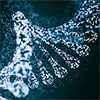Mar 02, 2022
(Nanowerk News) A research team led by the Technical University of Munich (TUM) has successfully used specific enzymes to destroy the genetic information of SARS-CoV-2 directly after the virus penetrates the cell (Nucleic Acids Research, “Targeting genomic SARS-CoV-2 RNA with siRNAs allows efficient inhibition of viral replication and spread”). The findings could serve as the basis for a therapy to treat COVID-19.
Our genome contains building instructions for proteins and other molecules. In order for these to be produced by the cell, a kind of transcript of these building instructions must first be created, which takes the form of so-called RNA molecules. The transcript is recognized and implemented by the cells.
“However, there is also a mechanism that can very specifically destroy this RNA, which takes place in all human cells as part of gene regulation,” explains Dr. Thomas Michler, who led the current study at the Institute of Virology of TUM and Helmholtz Zentrum München. “It is the so-called RNA interference.”
In this process, short pieces of RNA are formed in the cell, called siRNA (small interfering RNA). These segments can bond to specific spots in an RNA molecule. Together with proteins, the siRNA forms what is called the RNA-Induced Silencing Complex (RISC), an enzyme which then cuts the target RNA.
Start of the replication cycle as the most effective point of attack The research team primarily wanted to find out which of the virus RNA structures can be best attacked and at which step of the replication cycle treatment should take place. “Our main finding is that the RNA interference is most effective when the virus has just penetrated into the cell,” says Shubhankar Ambike, one of the study’s first authors. Here, siRNAs that selectively target the viral genome were superior to other siRNAs that target the subgenomic RNA molecules. Working together with colleagues at Ludwig Maximilian University of Munich and German Research Center for Environmental Health Helmholtz Zentrum München, the researchers also performed experiments on human lung tissue which they had infected with SARS-CoV-2. The experiments confirmed their results. In a follow-up project, the researchers are now planning to develop a method which can be used to bring the active ingredient into the lung in the most effective possible manner. The results could then serve as the basis for therapies to treat other viral respiratory diseases.
Virus introduces RNA into cell
“Efforts have been made for quite some time now to make therapeutic use of this mechanism,” says Ulrike Protzer, head of the TUM Institute of Virology. “A lot of progress has been made in this area over the last few years. Among other things, it is now possible to stabilize siRNA by chemical modifications so that it is not broken down so quickly in cells.” In SARS-CoV-2, there are two targets for RNA interference: First, the genome of the virus consists of RNA, which is introduced into the infected cell and contains the blueprint for new viruses. Second, so-called subgenomic RNA molecules are formed, which instruct the host cell to produce viral proteins.Start of the replication cycle as the most effective point of attack The research team primarily wanted to find out which of the virus RNA structures can be best attacked and at which step of the replication cycle treatment should take place. “Our main finding is that the RNA interference is most effective when the virus has just penetrated into the cell,” says Shubhankar Ambike, one of the study’s first authors. Here, siRNAs that selectively target the viral genome were superior to other siRNAs that target the subgenomic RNA molecules. Working together with colleagues at Ludwig Maximilian University of Munich and German Research Center for Environmental Health Helmholtz Zentrum München, the researchers also performed experiments on human lung tissue which they had infected with SARS-CoV-2. The experiments confirmed their results. In a follow-up project, the researchers are now planning to develop a method which can be used to bring the active ingredient into the lung in the most effective possible manner. The results could then serve as the basis for therapies to treat other viral respiratory diseases.

